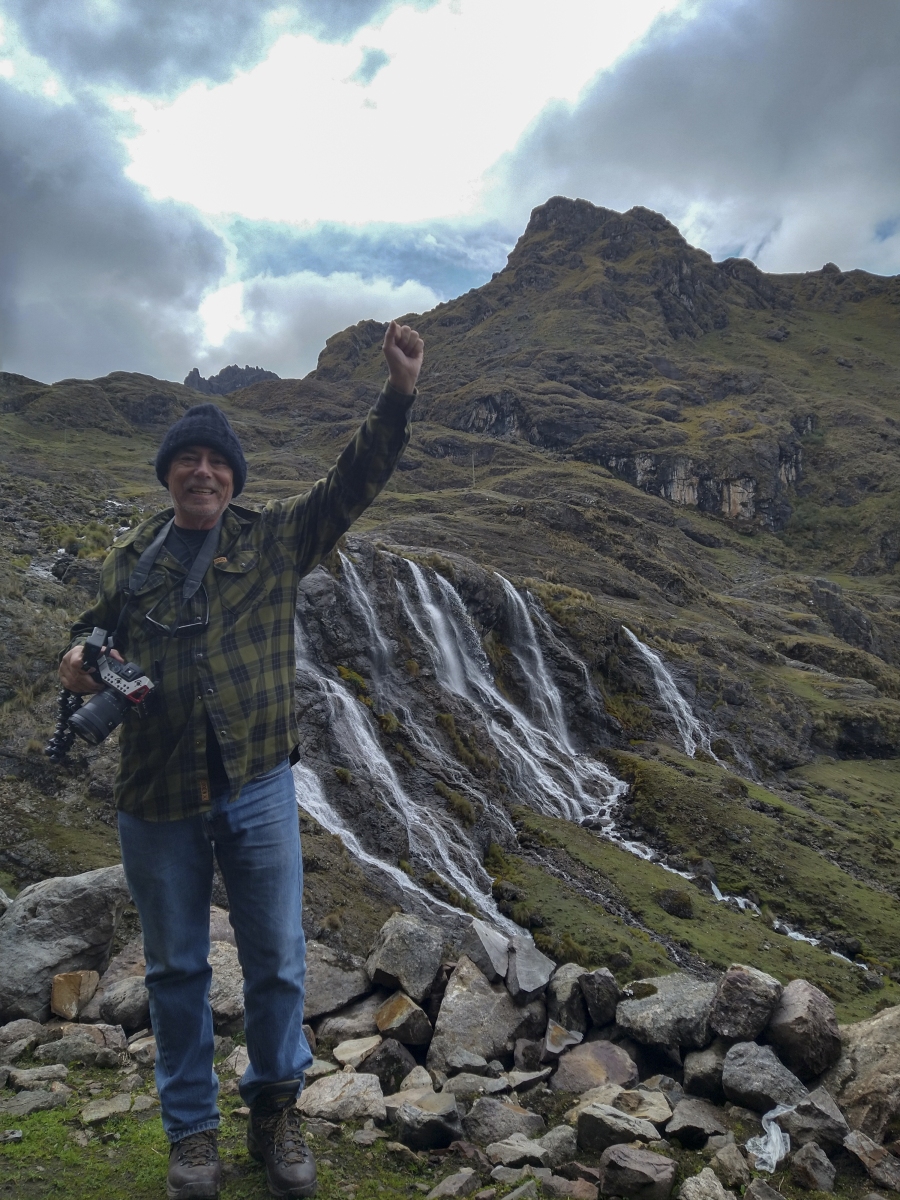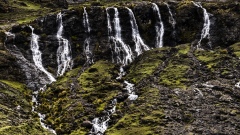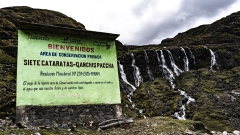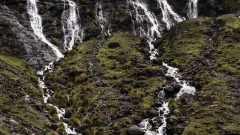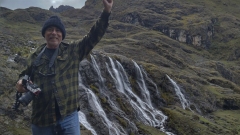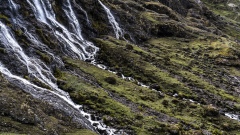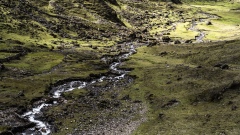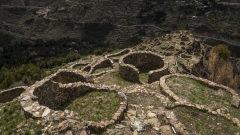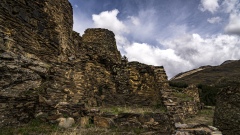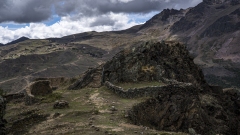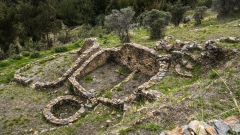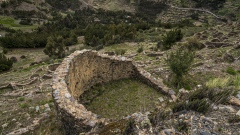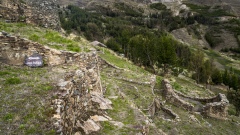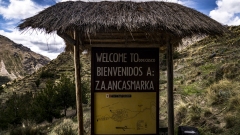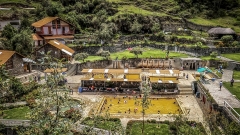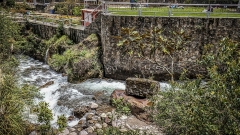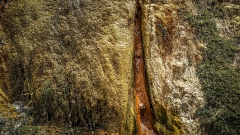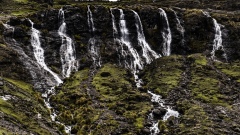In this blog, we show you How to Explore the Hidden Gems of Peru: Seven Waterfalls, Lares Hot Springs, and Ancasmarca Archaeological Park! I rode with a taxi driver and Tour Guide of Cusco yesterday, and we went to the CCoorca Inca Archeology Site on a half-day tour. The guide showed me photos of a recommended all-day tour of the Ancasmarca Archaeological Park, the Hot Springs of Lares, and finishing off hiking to the Seven Falls of Lares. I said, “Heck, Yes!” The next morning at 6:30 am, the guide picks me up with his taxi at the apartment I am staying at, and we head out for the day’s journey!
Let’s Go!
Las Siete Cataratas (Seven Falls)
The Seven Falls of Lares, Peru was the last stop and the highlight of the trip. We stop at the Ancasmarca Archaeological Park first and explore the Inca Ruins for two hours, next we go to the Hot Springs of Lares. At the Hot Springs we join the locals and soak in the hot mineral waters for an hour, and have a freshly cooked trout at the site, and now we are on the way to The Seven Falls. Here are the details of the day.
The Seven Falls of Lares, Peru is a series of stunning waterfalls located in the Lares Valley, a remote and scenic region in the east of the Urubamba mountain range. The Lares Valley is also home to many traditional weavers and farmers, who live in quaint villages and speak Quechua and Spanish. The Seven Falls are a hidden gem that few tourists know about, and a popular attraction for hikers who want to experience the natural beauty and cultural diversity of this area.
Mythology of Las Siete Cataratas
The Seven Falls are not only a visual spectacle, but also a place of historical and mythological significance. According to local legend, the falls were created by a young Inca princess who was fleeing from an unwanted marriage. She prayed to the gods for help, and they turned her into a stream of water that cascaded down the mountainside, forming seven falls along the way. The falls are also said to have healing properties and are a sacred site for the local people.
Getting There
To get to the Seven Falls by car, you will need to drive from Cusco, the former capital of the Inca Empire and a major tourist hub in Peru. The drive will take about five hours and will pass through some of the most famous Inca sites around the Sacred Valley, such as Písac and Ollantaytambo. You will also enjoy breathtaking views of the Andes mountains and the lush countryside.
Once you reach Lares, a small village at 10,660 feet (3,250 m) altitude, you will need to park your car and hike for about two hours to reach the falls. The hike is moderately challenging and will take you through some steep and rocky terrain. You will also cross several streams and bridges along the way. The hike is well worth it, as you will be rewarded with spectacular views of the falls and the surrounding landscape.
The top of the Seven Falls of Lares are at an altitude of 12,465 feet (3,800 m), about a 1,000 feet higher than Cusco where I am staying with walking and breathing difficult! The Seven Falls of Lares are a great destination for nature lovers and adventure seekers who want to experience a different side of Peru and an alternative to the more crowded and commercialized attractions in Peru, such as Machu Picchu,
Ancasmarca Archaeological Park
This was our first stop after starting our drive through the mountains and valleys of the Andes Mountain area. The guide stopped at one of the trailheads here, and we started exploring the ancient Pre-Inca and Inca ruins here. This area is not well traveled or even well known, and that is a shame, as these ruins are a fantastic look at the early history of the peoples of Peru. We spent ninety minutes hiking and exploring the large area and took a special look at the cylindrical rock formations constructed by the early settlers here.
After this stop, we continue our journey. We still have curvy, mountain roads to traverse, have a high mountain pass to cross, and then we will make our way to the Hot Springs of Lares.
The Park
The Ancasmarca Archaeological Park is a fascinating site that highlights the ancient culture and history of the Incas. The park covers an area of 250 acres (100 hectares) and is located between the villages of Calca and Lares in Peru’s Sacred Valley, the park features hundreds of circular structures that are believed to have been used as food storage units by the Inca civilization. These structures are called Qullqas (or Colcas) and they are found throughout the region, but Ancasmarca may be the most impressive and mysterious example of them.
The park covers a large area on a hillside and offers stunning views of the surrounding mountains and valleys. The site is also known for its high energy frequency, which some visitors claim to feel when they explore the ruins. Some speculate that the Qullqas may have had a different purpose than just storing food, such as being part of a ritual or astronomical system. However, the true meaning and function of these ancient constructions remain unknown.
Ancasmarca has a rich mythology and history associated with it. According to one legend, a shepherd and his six children survived a great flood by taking refuge on top of the hill, which rose as the waters increased. The children then repopulated the region after the flood subsided. Another version of the story says that the llamas warned the shepherd about the impending disaster by being sad and looking at the stars. The name Ancasmarca itself could mean either “blue village” or “village inhabited by eagles” in Quechua, the native language of the area.
Timeline of Ancasmarca
The timeline of the Ancasmarca Archaeological Park can be divided into four main phases:
- The Pre-Inca Phase: This phase corresponds to the period before the Inca expansion, from around 1000 to 1400 AD. During this time, the site was inhabited by local cultures such as the Killke and the Lupaca, who built some of the earliest structures in the park. They also developed agriculture and pottery techniques that influenced the later Inca culture.
- The Early Inca Phase: This phase corresponds to the period of the Inca conquest and consolidation, from around 1400 to 1438 CE. During this time, the site was incorporated into the Inca Empire by Pachacuti, the ninth ruler of the Inca dynasty. He ordered the construction of new buildings and terraces that improved the productivity and security of the site. He also established a provincial capital in Ancasmarca, where he appointed local governors and administrators.
- The Late Inca Phase: This phase corresponds to the period of the Inca expansion and splendor, from around 1438 to 1532 CE. During this time, the site reached its peak of development and population under the rule of Tupac Yupanqui and Huayna Capac, the tenth and eleventh rulers of the Inca dynasty. They expanded, embellished the existing structures, and added new ones that reflected their power and prestige. They also promoted cultural and religious activities in Ancasmarca, such as festivals, ceremonies and sacrifices.
- The Colonial Phase: This phase corresponds to the period of the Spanish invasion and colonization, from around 1532 to 1572 CE. During this time, the site was abandoned and destroyed by the Spanish conquerors, who looted and burned many of the buildings and terraces. They also imposed their religion and culture on the surviving Inca population, who were forced to work in mines and plantations. The site remained forgotten until the 20th century, when it was rediscovered and studied by archaeologists.
More Details of Ancasmarca
One of the most remarkable features of the park is the circular terraces that are arranged in concentric rings around a central hill. These terraces were used for agricultural purposes and also served as a defensive system against invaders. The terraces are connected by stone staircases and canals that provided irrigation and drainage.
The park also has other buildings that reflect the administrative, religious and military functions of the Inca society. There are granaries, warehouses, temples, palaces, towers and fortresses that demonstrate the architectural and engineering skills of the Inca people. Some of these structures are still well-preserved, and others have been partially restored by archaeologists.
Ancasmarca is a hidden gem that receives little to no tourists, making it an ideal destination for those who want to experience a more authentic and off-the-beaten-path adventure in Peru. The site can be visited independently or with a guided tour, and there are many other attractions nearby that can be combined with it, such as hot springs, waterfalls, and markets. Ancasmarca is a must-see for anyone interested in learning more about the ancient cultures and landscapes of the Andes.
Aguas Termales de Lares
The Hot Springs of Lares is our second stop of the day. This is a genuinely nice stop for me, let me give you some background information. I am staying in a shared apartment with four bedrooms and two other roommates – one from China and one from Germany. Both of their English is not great, and my Chinese and German is non-existent, so our common language is Spanish!
But back to the hot springs being important is the plumbing and water heating here in Cusco is hit or miss, and ours is mostly a miss. We have lukewarm shower water at best, and most of the time it is rather cold! After two weeks of cold showers, a soaking in a mineral hot springs sounds like heaven, and it is! The guide reminds me to bring swim trunks along, and I do. We pay an inexpensive entrance fee, and you can go to any one of the several hot spring-fed pools here. I try different pools and find the one that was exactly right to soak in for an hour. After an hour, we shower and continue our journey.
It is lunchtime as we leave, and there are Peruvian women with booths selling meals and snacks. We sat at one and ordered fresh trout dinners from the river that ran along the site. Our cook had a propane stove and cooked up our dinners right in front of us, with her two young children peeking at us. Peru is famous for potatoes and corn, and we had heaping portions of both along with our freshly grilled trout. The meal was delicious and did not cost much at all. We finished our meal and headed back to the taxi to head to the Seven Falls of Lares for our last stop of the day.
Hot Springs of Lares
The Hot Springs of Lares are a natural wonder nestled in the Andes Mountains of Peru, about 40 miles north of Cusco. They are a popular destination for travelers who want to relax and enjoy the healing properties of the mineral-rich water. The hot springs have a long history and mythology that date back to the pre-Columbian civilizations.
The hot springs consist of seven pools with different temperatures, ranging from mild to scalding. The water is rich in minerals such as calcium, magnesium, iron, and sulfur, which are beneficial for the skin, bones, muscles, and blood circulation. The pools are surrounded by tall stone walls that provide privacy and protection from the wind. There are also outdoor showers that use natural hot water from the springs. The scenery around the hot springs is breathtaking, with green fields, snow-capped mountains, and blue skies.
Mythology of the Hot Springs of Lares
According to some sources, the hot springs were discovered by the Inca emperor Pachacuti, who was looking for a place to heal his wounds after a fierce battle. He found the hot springs and was astonished by their soothing effect. He decided to build a majestic palace near the springs and named them Lares, which means “place of healing” in Quechua. He also ordered the construction of stone walls and terraces around the pools to create a more comfortable and secluded environment.
The hot springs have also been associated with various legends and myths. One of them tells that the water comes from the tears of a princess who was in love with a young warrior. The warrior died in a war and the princess cried so much that her tears formed the hot springs. Another legend says that the water is a gift from the gods, who wanted to reward the people of Lares for their loyalty and courage. The water is said to have magical powers that can cure diseases, grant wishes, and even make people fall in love.
The People of the Area
The people that live in Lares are mostly Quechua-speaking farmers and herders who have preserved their traditional way of life for generations. They wear colorful clothing made from alpaca wool and cultivate crops such as potatoes, corn, quinoa, and beans on their terraces. The people here raise animals such as llamas, alpacas, sheep, cows, and pigs. They are friendly and hospitable to visitors, and some of them offer homestays or camping options for those who want to spend more time in the area. You can also buy some of their handicrafts such as hats, scarves, gloves, and blankets as souvenirs.
Getting There
The Hot Springs of Lares are located in a small town called Lares, about 40 miles north of Cusco. To get there, you will need to take a bus or a collectivo (shared taxi) to Calca, a town in the Sacred Valley. From Calca, you will need to find another car or van to go to Lares. The ride from Calca to Lares is a rollercoaster of a drive, with a one-lane mountain pass that winds up and down some 14,000 feet above sea level. You will see stunning views of terraced mountains, glaciers, streams, and llamas along the way. The trip can take anywhere from 2 to 4 hours, depending on the traffic and weather conditions.
Once you arrive in Lares, you can walk 0.6 miles uphill to the hot springs or ask your driver to take you there. The entrance fee is 10 soles (about $3 USD) and you can rent a towel for another 5 soles (about $1.50 USD). There are two resorts in Lares, but I recommend the one with four hot pools, one large warm pool, one cold pool, and many warm showers. The pools are colored by minerals, but do not smell like sulfur. The spot is in a valley between two almost vertical mountains, and sitting in the steaming water looking up at them is an amazing experience. The pools are open all day and night, and bathing under the stars is highly recommended.
The Hot Springs of Lares are a must-see attraction for anyone who visits Peru. This place offers a unique opportunity to experience the culture, history, and nature of this amazing country. It is also a wonderful place to relax, rejuvenate, and enjoy the beauty of the Andes.
What an Adventure!
This was an 12-plus hour tour and ride through the Andes Mountains to three fantastic, hidden attractions in the Lares area outside Cusco. And after this trip I talked to both locals and tourists that have been in Cusco for some time, and most did not know about these places, and no one I talked to had ever been there!
One other fact, my taxi driver and tour guide only spoke Spanish and Quechua (the original language of the Inca). My Spanish is good enough to understand almost all of what he is saying about the various places that we visited. The day was a learning the history and geography of Peru, and a practicing language skills endeavor. A day well spent!
See our adventures on YouTube: @HBMaverick
Visit our blog: Huaca Pucllana – A Remarkable Pre-Inca Archaeological Site in Lima
“We will see YOU on the next adventure!”

